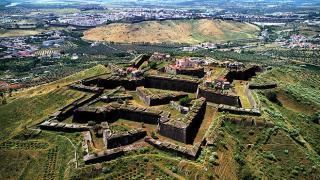Country Portugal Local time Thursday 3:54 PM | Region Alentejo Intermunic. comm. Alto Alentejo Parishes 7 Population 23,078 (2011) | |
 | ||
Weather 27°C, Wind E at 13 km/h, 36% Humidity Points of interest Nossa Senhora da Graça, Castle of Elvas, Aira Aqueduct, Museu de Arte Contemp, Museu Militar do Forte de | ||
Elvas ([ˈɛɫvɐʃ]) is a Portuguese municipality, an episcopal city and frontier fortress of Portugal, located in the district of Portalegre in Alentejo. It is situated about 230 kilometres (140 mi) east of Lisbon, and about 15 kilometres (9.3 mi) west of the Spanish fortress of Badajoz, by the Madrid-Badajoz-Lisbon railway. The municipality population as of 2011 was 23,078, in an area of 631.29 square kilometres (243.74 sq mi). The city itself had a population of 16,640 as of 2011.
Contents
Map of Elvas, Portugal
Elvas is among the finest examples of intensive usage of the trace italienne (star fort) in military architecture, and has been a World Heritage Site since 30 June 2012. The inscribed site name is Garrison Border Town of Elvas and its Fortifications.
History
Elvas lies on a hill 8 kilometres (5.0 mi) northwest of the Guadiana river. It is defended by seven bastions and the two forts of Santa Luzia and Nossa Senhora da Graça. Its late Gothic cathedral, which has also many traces of Moorish influence in its architecture, dates from the reign of Manuel I of Portugal (1495–1521). An aqueduct 6 kilometres (3.7 mi) long supplies the city with pure water; it was begun early in the 15th century and completed in 1622. For some distance it includes four tiers of superimposed arches, with a total height of 40 metres (130 ft). The surrounding lowlands are very fertile, and Elvas is known for its olives and plums, and exports the latter, either fresh or dried, in large quantities. Brandy is distilled and pottery manufactured in the city.
It was wrested from the Moors by Afonso I of Portugal in 1166 but was temporarily recaptured before its final occupation by the Portuguese in 1226. In 1570 it became an episcopal see. From 1642 until modern times it was the chief frontier fortress south of the Tagus; and it withstood sieges by the Spanish, in 1659, 1711 and 1801. Elvas was the site of the Battle of the Lines of Elvas in 1659, during which the garrison and citizens of the city assisted in the rout of a Spanish Army. The Napoleonic French under Marshal Junot took it in March 1808 during the Peninsular War, but evacuated it in August after the conclusion of the Convention of Sintra. The fortress of Campo Maior 15 kilometres (9.3 mi) to the northeast is known for its Napoleonic era siege by the French and relief by the British under Marshal Beresford in 1811, an exploit commemorated in a ballad by Sir Walter Scott. The Garrison Border Town of Elvas and its Fortifications were added to the list of UNESCO World Heritage Sites in 2012.
Parishes
Administratively, the municipality is divided into 7 civil parishes (freguesias):
